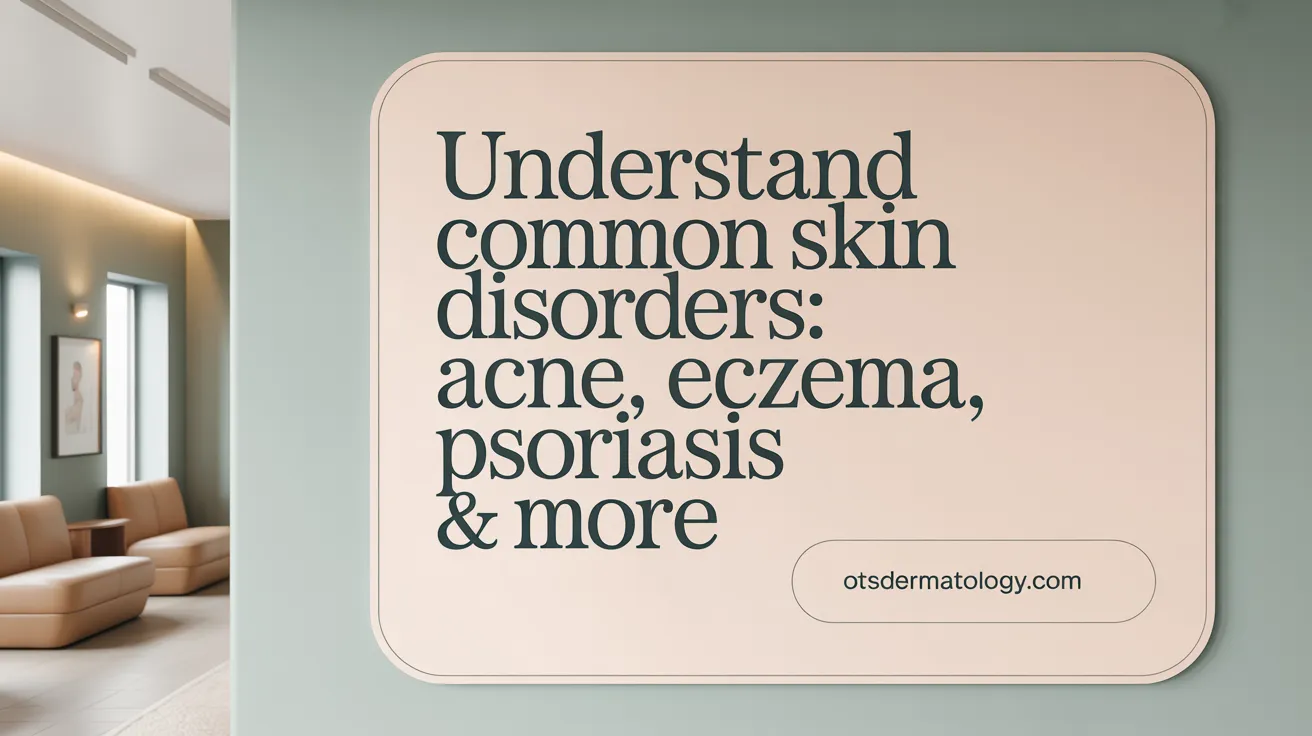Introduction to Dermatological Conditions
Skin health is a crucial aspect of overall wellness, yet many patients seek clear, reliable information about the common conditions that affect this vital organ. Understanding the various dermatological diseases, their causes, symptoms, and management strategies empowers patients to take proactive steps for healthy skin. This article provides an educational overview tailored for patients, aiming to demystify common skin disorders and highlight effective prevention and treatment approaches.
Overview of Common Dermatological Conditions

What are the common types of dermatological conditions?
Dermatological conditions encompass a broad spectrum of disorders affecting the skin, hair, and nails. The most common skin issues include acne, eczema (also called atopic dermatitis), psoriasis, and rosacea. These often manifest through symptoms such as redness, itching, dryness, and inflammation.
Acne primarily results from blocked hair follicles due to oil, bacteria, and dead skin cells, affecting areas like the face, chest, and back. Eczema causes itchy, inflamed, and sometimes weeping skin, frequently triggered by allergens or irritants. Psoriasis leads to thick, scaly patches that may be painful or hot to the touch, while rosacea causes persistent redness and visible blood vessels on the face.
Other notable conditions include fungal infections like candidiasis, which can cause rashes, and skin cancers such as basal cell carcinoma—highly preventable through sun protection. Autoimmune diseases like lupus and pemphigus result in skin lesions or blistering, often requiring specialized treatment. Pigmentary changes, like vitiligo, lead to patches of depigmented skin.
Hair loss issues, including alopecia areata—where the immune system attacks hair follicles—and telogen effluvium, typically caused by stress or hormonal imbalance, are also frequent concerns.
Prevention strategies include maintaining good skin hygiene, protecting the skin from excessive sun exposure with sunscreen, and avoiding injuries or irritants. Recognizing these common conditions early can lead to better management and improve quality of life for affected individuals.
Causes and Classification of Skin Diseases

What are the typical causes of common skin diseases?
Skin diseases can originate from a variety of causes, broadly categorized into infectious and non-infectious origins. Infectious causes include bacteria, fungi, viruses, and parasites. These microbes can infect the skin directly or cause inflammation, leading to conditions such as impetigo, ringworm, or warts. Fungal infections like athlete’s foot or candidiasis are common examples.
Non-infectious causes often involve genetic, autoimmune, or environmental factors. Genetics play a significant role in diseases like eczema or psoriasis, which tend to run in families. Environmental triggers such as sun exposure, contact with irritants, or allergens can provoke reactions like dermatitis. Underlying health conditions—such as diabetes or thyroid disorders—and hormonal changes, especially during pregnancy or due to stress, also predispose individuals to skin problems.
Lifestyle choices, including poor hygiene, dehydration, or the use of harsh chemicals, can worsen skin conditions. Additionally, immune system disorders may cause or exacerbate skin inflammation, highlighting the complex interplay of internal and external factors in skin health.
What is the classification of skin diseases and why is it important?
Classifying skin diseases involves categorizing them based on their causes, appearance, and underlying mechanisms. Common systems like the British Association of Dermatologists Index help in organizing these conditions into groups such as infectious, inflammatory, genetic, or neoplastic (cancerous) disorders.
This classification is crucial for accurate diagnosis and effective treatment. For example, identifying whether a skin lesion is due to an autoimmune process like psoriasis or a contagious infection like impetigo influences how it should be managed. It also helps in recognizing the urgency of certain diagnoses—such as skin cancer—necessitating prompt intervention.
Recent technological advances incorporate deep learning and imaging analysis to improve classification precision, especially for complex or rare disorders. Overall, a structured classification provides a common language for healthcare providers, facilitates research, and improves patient care by guiding targeted therapies.
| Aspect of Classification | Examples | Importance |
|---|---|---|
| Cause | Infectious, genetic, autoimmune | Guides diagnosis and treatment choice |
| Morphology & Site | Eczema (red, inflamed skin), psoriasis (scaly patches), skin cancer | Aids in differentiating conditions |
| Mechanisms & Pathogenesis | Inflammation, neoplasm, immune response | Enhances understanding of disease progression |
Understanding the causes and classification of skin diseases is fundamental for effective management and creating tailored treatment plans to improve patient outcomes.
Recognizing Symptoms and Signs of Skin Conditions

What are the main symptoms to identify different dermatological conditions?
Skin conditions often present with a variety of symptoms that can guide diagnosis and treatment.
The most common signs include redness, itching, and inflammation, which appear across many skin disorders. These symptoms are often accompanied by dryness, scaling, or changes in skin texture and color.
Different skin diseases have unique visual markers. For example, psoriasis causes red, thickened, and silvery-scaled patches. Eczema presents with inflamed, itchy, and sometimes oozing skin, while vitiligo results in patches of depigmented skin.
Additional signs to watch for include raised bumps, such as pustules or nodules, ulcers or open sores, and unusual growths. Changes in moles or spots, skin thickening, blistering, or the appearance of rashes are important indicators of more serious conditions like skin cancer or autoimmune skin diseases.
Infections like impetigo show honey-colored crusts, while fungal infections such as ringworm feature ring-shaped rashes with scaling and redness.
Paying attention to these signs and how they evolve over time helps healthcare providers accurately diagnose and manage skin conditions effectively.
| Symptom | Common Skin Diseases | Unique Features | Additional Notes |
|---|---|---|---|
| Redness | Eczema, rosacea | Diffuse or localized areas of inflamed skin | Often triggered by irritants or stress |
| Itching | Eczema, psoriasis, hives | Can be severe and persistent | May lead to skin damage if scratched |
| Scaling or Flaking | Psoriasis, eczema | Thick scales in psoriasis, flaky patches in dermatitis | Signs of chronic inflammation |
| Bumps or Nodules | Acne, psoriasis | Pustules, cysts, or raised solid areas | Often associated with infection or hormonal changes |
| Open Sores or Ulcers | Skin infections, psoriasis | May ooze or crust | Can become infected if untreated |
| White or Depigmented Patches | Vitiligo | Loss of pigment in patches | Usually not itchy or painful |
| Thickened Skin | Psoriasis, scleroderma | Hyperkeratosis, leathery appearance | Related to chronic inflammation or autoimmune processes |
How are skin conditions diagnosed?
Diagnosis generally begins with a visual examination by a healthcare professional.
To confirm the diagnosis or identify specific conditions, various tests can be performed:
- Skin biopsy: a small tissue sample examined microscopically
- Cultures: to identify bacterial, fungal, or viral infections
- Patch testing: for allergic contact dermatitis
- Dermoscopy: magnified examination of skin lesions
- Tzanck test: to detect herpes infections
These tools help differentiate between conditions that may look similar but require different treatments. Early and accurate diagnosis is crucial for effective management and better outcomes.
Treatment Strategies for Common Skin Conditions

What are the usual treatments available for skin conditions like acne, eczema, rosacea, and psoriasis?
Treatments for skin conditions such as acne, eczema, rosacea, and psoriasis depend on their nature and severity. A variety of methods are used to help manage symptoms, reduce flare-ups, and improve skin appearance.
Medication types
Most skin conditions are treated with topical medications. For acne, topical treatments include benzoyl peroxide, salicylic acid, and topical antibiotics. Eczema and psoriasis often respond to corticosteroids, vitamin D analogs, and calcineurin inhibitors. Rosacea treatments may involve topical antibiotics, metronidazole, or azelaic acid. In more severe cases, doctors may prescribe oral medications such as antibiotics, antihistamines, or immune-modulating drugs like methotrexate or cyclosporine. Biologic agents, which target specific parts of the immune system, are increasingly used for conditions like psoriasis and severe atopic dermatitis.
Therapies and procedural treatments
Light-based therapies like phototherapy can significantly reduce inflammation, redness, and abnormal skin cell growth. Laser treatments are also utilized to diminish visible blood vessels and scars. Chemical peels and microdermabrasion can improve skin texture and appearance, especially in psoriasis plaques and acne scars. Cryosurgery might be employed for specific lesions or precancerous spots.
Lifestyle modifications
Good skin care routines are essential. Using gentle cleansers, avoiding harsh soaps, and ensuring skin is adequately moisturized help maintain the skin barrier. Protecting skin from sun damage with broad-spectrum sunscreen and protective clothing is crucial, particularly for psoriasis and rosacea. Managing stress levels can lessen flare-ups, as stress often exacerbates skin conditions. Avoiding known triggers, such as spicy foods, alcohol, or extreme weather, can also make a significant difference.
Managing chronic versus acute conditions
Chronic skin diseases like psoriasis and eczema often require ongoing treatment plans, including daily skincare routines and regular medical reviews. During flare-ups, more intensive therapy may be needed, including systemic medications. Acute conditions, such as bacterial infections or sudden dermatitis, might be treated with short-term antibiotics or steroids.
By combining medication, procedural options, and lifestyle adjustments, most patients can manage their skin conditions effectively. Consultation with a dermatologist is essential to tailor treatments suitable for each individual’s needs.
| Condition | Common Treatments | Additional Notes |
|---|---|---|
| Acne | Topical agents, oral antibiotics, hormonal therapy | Prevents scarring, improves appearance |
| Eczema | Corticosteroids, moisturizers, antihistamines | Reduces itching and inflammation |
| Rosacea | Topical antibiotics, laser therapy | Manages redness and visible blood vessels |
| Psoriasis | Topical treatments, phototherapy, biologics | Controls skin thickening and scaling |
Prevention and Effective Management of Skin Health

How can skin conditions be prevented and managed effectively?
To keep skin healthy and prevent common issues, good hygiene practices are fundamental. Regular hand washing, gentle bathing with mild cleansers, and using appropriate moisturizers help maintain the skin’s protective barrier.
Protecting the skin from environmental triggers is also vital. This includes avoiding overexposure to sunlight, which can cause burns and skin damage, and steering clear of irritants or allergens that may trigger allergic reactions or dermatitis. Using protective clothing, applying broad-spectrum sunscreen, and wearing hats or sunglasses are effective measures.
Trigger avoidance is essential especially for conditions like rosacea and psoriasis, which can flare with certain foods, stress, or weather changes. Identifying and steering clear of these triggers can reduce flare-ups and improve quality of life.
Early diagnosis plays a big role in managing skin conditions successfully. Recognizing symptoms early and seeking prompt medical attention allows for timely treatment, minimizing severity and preventing complications such as scarring or infections.
For individuals with chronic or coexisting health issues like diabetes, lupus, or immune disorders, controlling these underlying conditions can improve skin health. Regular medical check-ups and adhering to prescribed treatments are important.
Overall, adopting healthy habits, avoiding known irritants, and consulting healthcare providers when symptoms arise are key to effective skin health management. Combining these strategies helps prevent many skin problems and ensures better treatment outcomes.
The Role of Understanding Skin Health in Dermatological Care
How does understanding skin health contribute to better dermatological care?
Understanding skin health is essential for effective dermatological care because the skin is our body's largest organ and serves multiple critical functions. It acts as a barrier against environmental threats like bacteria, viruses, fungi, and UV radiation, protecting internal organs and tissues.
Recognizing early signs of skin issues—such as unusual moles, persistent rashes, or discolorations—allows clinicians to diagnose conditions promptly. Early detection of problems like skin cancer or inflammatory skin diseases like eczema and psoriasis can lead to more successful treatments and prevent disease progression.
Knowledge of skin health also underscores the importance of prevention. Simple practices such as using sunscreen, maintaining good hygiene, and avoiding irritants or allergens can significantly reduce the risk of developing severe skin conditions.
Advances in dermatology research, including the understanding of the skin microbiome and new therapeutic options like biosimilars and FDA-approved treatments for conditions like atopic dermatitis, further improve patient outcomes.
Furthermore, a nuanced grasp of how systemic health impacts the skin—such as the effects of diabetes, lupus, or stress—allows for holistic management approaches that improve overall health.
In summary, understanding skin health not only helps in early diagnosis and effective treatment but also promotes preventive strategies, enhancing overall well-being and reducing the burden of skin diseases.
Conclusion: Empowering Patients Through Knowledge
A thorough understanding of common dermatological conditions equips patients to recognize early symptoms, seek timely medical advice, and actively participate in treatment and prevention strategies. With a broad spectrum of skin diseases ranging from infectious to chronic autoimmune disorders, knowledge of causes, classifications, and treatment options is essential for effective management. Emphasizing skin health through proper care, lifestyle adjustments, and awareness fosters improved outcomes and enhances quality of life. Patients are encouraged to maintain open communication with healthcare providers and stay informed about evolving research, ensuring optimal dermatological care and skin wellness.
References
- Skin Diseases: Types of, Symptoms, Treatment & Prevention
- Skin Diseases, Conditions, & Disorders | NIAMS
- Skin Conditions | Hives | Acne
- Understanding Common Skin Conditions and How to ...
- Skin Conditions (Overview)
- Diseases and conditions
- Psychodermatology: A Guide to Understanding Common ...
- Common Skin Conditions: What's Contagious and ...
- Skin Diseases: Types of, Symptoms, Treatment & Prevention
